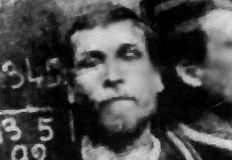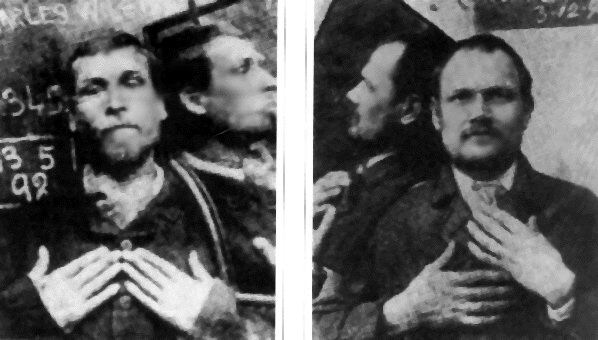Police had been called to the Muswell Lodge home of
79-year-old widower Henry Smith on the Friday 14th February 1896 by
his gardener, Charles Webber. When he had arrived for work he had
found the body of his employer, still in his night-shirt, lying on the
kitchen floor. It was quite obvious that the old man had been beaten
to death. His arms had been tied to his sides with strips of a
tablecloth and he had been gagged.
Next to the body, one either side, were two
penknives and nearby was found a small toy lantern. Mr Smith had had a
fear of burglars and he had the gardener set up alarms and mantraps in
the garden of the large, decaying mansion, but these had not been set
off. The sitting-room and scullery windows showed marks of being
tampered with before the killers had gained entry by way of the
kitchen window. The noise had obviously disturbed Mr Smith who had
been bludgeoned when he came to investigate. The safe in his bedroom
had been opened and rifled.
Investigations revealed that two men had been seen
hanging around the Muswell Lodge area two days prior to the murder.
Descriptions of these men fitted Milsom and Fowler and, when it was
discovered that both men had vanished from their usual haunts,
warrants for their arrest were obtained. Albert Milsom was a 33-year-old
petty criminal.
His partner, 31-year-old Henry Fowler, was a huge,
vicious brute of a man who was on parole. They were both labourers by
trade and lived in the King's Cross district of London. When the
families of the men were questioned Milsom's brother-in-law, 15-year-old
Henry Miller, identified the toy lantern as belonging to him.
A postmark on a letter led to them being arrested
in Monmouth Street, Bath, on Sunday 12th April but not before Fowler
put up fierce resistance and had to be subdued with the butt of a
police revolver. The pair had spent their time on the run with a
travelling show. They both admitted involvement in the robbery but
both accused the other of committing the murder.
At their trial which opened at the Old Bailey on
19th May the evidence was overwhelming and the jury had no problem
finding them both guilty. They were sentenced to death. On 9th June
they were hanged by James Billington, along with a third man named
Warbrick, at Newgate Prison. It was the last triple execution at this
prison and the prison was demolished in 1902 with the gallows being
removed to Pentonville.
1896 June 9th
Albert MILSOM (33)
Henry FOWLER (31)
Newgate
On 14 February, the body of Henry Smith (79), a
wealthy retired engineer, was discovered battered to death in the
kitchen of his home at Muswell Hill. He had been bound and gagged.
Evidence suggested he had been tortured, probably to reveal the
combination of his safe which stood empty.
Fowler and Milsom, two well known thugs had been
seen in the area on the day before the crime, but the only clue the
police had was a child's toy lantern found in the grounds outside the
house. When detectives learned that the toy had once belonged to a
relative of Milsom, a manhunt was started.
The two were eventually located in Bath, and
although Fowler strenuously denied any involvement with the crime,
Milsom cracked under interrogation and made a full confession. They
were convicted on overwhelming evidence at the Old Bailey and as they
were sentenced to death, Fowler made a desperate attempt to strangle
his former associate who had landed him in the dock.
Albert Milsom and Henry Fowler
murdered Henry Smith, a 79-year–old, wealthy, retired engineer, on 14
February 1896, at his house in Muswell Hill, London.
The story of the murder of Mr. Smith has entered
English Criminal history as one of the classic "cut-throat" cases
involving a pair of killers. A "cut-throat" case is one where the
killers each put forth a defence that the other one was guilty, and in
doing this they only convince the jury that both parties are equally
guilty of the killing. Another example of such a case is that of
Frederick Guy Browne and William Kennedy for the murder of Police
Constable George Gutteridge in 1928.
Muswell Hill was a wealthy neighbourhood in North
London. In 1896 the elderly Smith lived there in a large house called
Muswell Lodge. Smith was somewhat reclusive, and rumour had it he was
a wealthy miser keeping large sums of money in the house. He lived
alone (though he had a gardener in the daytime), and apparently pegged
his safety on some trap-guns set up on the grounds; unfortunately, he
did not have any secondary level of protection.
Smith's body was discovered on the morning of 14
February, a few hours after his murder, by his gardener, Charles
Webber, who alerted Smith's neighbours, called in a local doctor (Ridley
Webster, M.D.), and notified the police. They entered the house and
found that Smith had been bound with shreds of blankets and had
sustained several head wounds. Two pocket knives and a toy lantern
were found next to the body. Smith's safe had been cracked and his
bedroom torn apart. The day before the murder two men had been seen
near the house.
For weeks the police tried to find the killers,
using the toy lantern as the best clue they had. Unfortunately
hundreds were in existence, so it was a clue that might never be
traced. Instead, a Detective named William Burrell was aware of a
burglar named Albert Milsom who had disappeared from his neighbourhood.
Milsom had recently been seen in the company of one Henry Fowler.
Fowler was also a burglar, but a violent person as well (far more
notably violent than the somewhat cowardly Milsom). Burrell was aware
of the younger brother-in-law of Milsom reportedly having a toy
lantern, but understood he could not question him or other members of
the family about it without tipping them off about its significance. A
trap was set at a nearby candy store, where the lantern was set up.
The trap succeeded when Milsom's brother-in-law, Henry Miller,
identified the lantern as his own.
Now that they were aware that it was Milsom whom
they wanted, and that Fowler was missing as well, the police started a
manhunt. It eventually turned out that the men were together in a
small travelling waxworks that journeyed to fairs around the country,
with Fowler acting as the strong man in the circus. A police raid
captured both men at Bath. Milsom gave up meekly, but Fowler fought
like a tiger and had to be clubbed into submission.
Fowler denied knowing anything about the murder,
but Milsom soon cracked under the strain and confessed to robbing
Smith, though he said his partner had done the killing. Their trial
was held in the Old Bailey in front of Mr. Justice Sir Henry Hawkins.
The evidence was basically streamlined because of Milsom's confession,
although Fowler kept denying its truth. Fowler was aware of the great
damage Milson had done. During a break in the trial, Fowler suddenly
jumped up in the dock, and started throttling him. A number of
policemen interfered and pulled Fowler off the cowering Milsom.
As it turned out the jury believed Milsom in part -
the evidence had shown two knives near the dead Smith, and that
suggested the two burglars had jointly committed the tying up and
killing of the man. Milsom collapsed when he heard the guilty verdict
against him. Fowler just laughed at the failure of Milsom's scheme,
and mimicked his partner's protesting of the verdict. Interestingly
enough, when asked if they had anything further to say, Fowler told
the court that there were two miscarriages of justice for which he was
responsible, naming two recent convictions of two burglars for whose
crimes Fowler claimed responsibility. He asked the court to keep these
in mind for reviewing those two sentences. As it turned out, Fowler
was lying - the evidence against the two burglars was stronger than
Fowler thought, and they (the two burglars) were friends of his for
whom he was trying to do a favour.
The authorities were afraid that when Milsom and
Fowler were going to be hanged Fowler might attack Milsom again. It
was decided to hang the two men with a third one between them. A
recent double murder had been committed in the Whitechapel section of
London of a pawnbroker named John Goodman Levy and his housekeeper,
Mrs. Sarah Gale by a burglar named William Seaman. Seaman was cornered
while still in Levy's home on the roof. He was subdued in a violent
fight by future Chief Constable of Scotland Yard, Frederick Porter
Wensley. Seaman too was sentenced to death, and he was put between
Milsom and Fowler on the gallows built at Newgate Prison on 9 June
1896. Actually, despite fears by the executioner John Billington
Fowler did not make a scene. He came out onto the scaffold after
Milsom and Seaman were set up, asked if Milsom was there, and was
satisfied to see he was. Seaman, until then unaware of why he was
being placed as he was between the Muswell Hill murderers, said, "Well
this is the first time in my life I've ever been a bloody peacemaker."
Shortly afterwards all three men were hanged.
Usually this is the end of the anecdote about the
triple execution of 9 June 1896. There is a little more involved in it.
At one point there was a chance that there would have been a quadruple
hanging because Amelia Dyer the notorious baby farmer, was supposed to
be hanged with them, but it was decided that Mrs. Dyer should be
hanged the following day. She was taken out of the prison and taken
for a police wagon ride until after the three men were executed. Also
at least one source adds to the anecdote about Seaman's final words on
the scaffold. Edward Abinger the barrister best recalled for his
defence of Steinie Morrison in 1910, wrote an autobiography. In it he
reveals that a moment after Seaman made his comment, Fowler signaled
he wanted to say something. It is possible that Seaman's comment
struck Fowler as funny, and he said (according to Abinger), "Well this
is the first time in my life I've ever been a bloody penitent." But
Abinger is the only person who ever seems to have noted that comment.
Wikipedia.org


